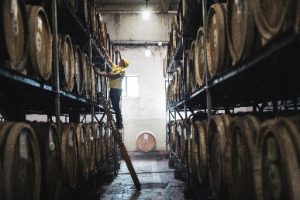World Whiskey Day: Safety and Health for Bourbon Distillery Workers
Posted on byThe blog content comes from the NIOSH Manufacturing Mondays seminar series.

Saturday, May 21, 2022 is World Whiskey Day Founded in 2012 by a Scottish college student, the day is now recognized by whiskey drinkers all over the world to celebrate their favorite spirit. There are historical references to whiskey dating to at least the 15th century. The term itself comes from a Gaelic word that means “water of life.” There are many spirits that come under the general term whiskey – scotch whisky, bourbon whiskey, rye whiskey, Irish whiskey, Canadian whisky. [There is a difference in spelling between the spirits that originated in Scotland vs. Ireland, that is why the ‘e’ is not always present. Good tidbit for Trivia Night!] For World Whiskey Day this year, we are going to focus on the production of a particular type of whiskey: bourbon.

Bourbon is a whiskey made from a mash of grains that is at least 51% corn. The remainder of the mash is some combination of wheat, malted barley, or rye. The mash is mixed with water and yeast and heated. This mixture is then fermented in a vat for a week or two to produce alcohol. Sour mash (mash remaining from a previous distillation) and yeast are added to the mixture. The purpose of the sour mash is to help prevent bacterial growth by lowering the pH of the mixture. The solids are removed leaving the liquid which is then used for bourbon production. The alcohol is then distilled, usually twice, to increase the alcohol percentage. When the desired alcohol content is reached, the liquid is placed in new charred oak barrels for aging. The conditions for aging, the amount of char in the barrel, and other factors determine the taste and quality of the final product.

Although the process is straightforward, there are numerous health and safety hazards for distillery workers. The number one threat historically has been fire. Not only are there huge vats filled with flammable liquid, but the ethanol vapors emitted during the distilling process and cask storage (often called the angels share) are also subject to ignition. It is essential to have proper ventilation in the barrel houses to mitigate this risk. Warehouses filled with bourbon aging in wooden barrels have been struck by lightning, causing huge fires that risk workers’ lives. The grains used in the mash are usually dried and ground, creating large quantities of flammable dust. Barrel handling is another source of worker injury. Workers have been crushed by or pinned between falling barrels. Checking on barrels in large racks often involves working at heights. Burn and scald injuries, exposure to chemical cleaning agents, confined spaces, slips, trips, and falls all pose threats to workers. Current practices have increased the overall health and safety for workers in the industry, but the industry is mostly self-regulated.

A relatively new concern is the safety of smaller craft distilleries. These operations typically are housed in small spaces that may be near other businesses. They tend to have small staff and lack comprehensive safety management. While a large warehouse fire in a rural area may only threaten the employees at the distillery, a boiler explosion in a strip mall could be catastrophic for other businesses and patrons.
Whiskey production dates back hundreds of years. If you choose to celebrate World Whiskey Day this weekend, consider raising a glass to worker safety.
For more information
How Bourbon is Made: Inside the Bourbon Production Process
Bourbon Basics – From Barrel to Bottle
Death and Destruction: The Risks of Whiskey Making
Workers′ compensation reported injuries among distillery industry workers, 2010–2019- AJIM
RJ Matetic, MS, PhD, NIOSH Associate Director for Manufacturing
Gary Roth, MS, PhD, NIOSH Manufacturing Sector Program Co-Coordinator
Jenny Topmiller, MS, NIOSH Manufacturing Sector Program Co-Coordinator
Richard Current, PE, NIOSH Manufacturing Sector Program Assistant Coordinator
Adam Smith, PhD, NIOSH Manufacturing Sector Program Assistant Coordinator
The blog content comes from the NIOSH Manufacturing Mondays seminar series. The Manufacturing Program uses Mondays to highlight happenings within the program and throughout the world of Manufacturing. Some weeks feature seminars by internal or external speakers while others will share recent news and interesting facts related to the Manufacturing community. Many of these topics will also be highlighted here on the NIOSH Science Blog. To share your ideas for future topics contact us at mnf-program@cdc.gov.
Posted on by

